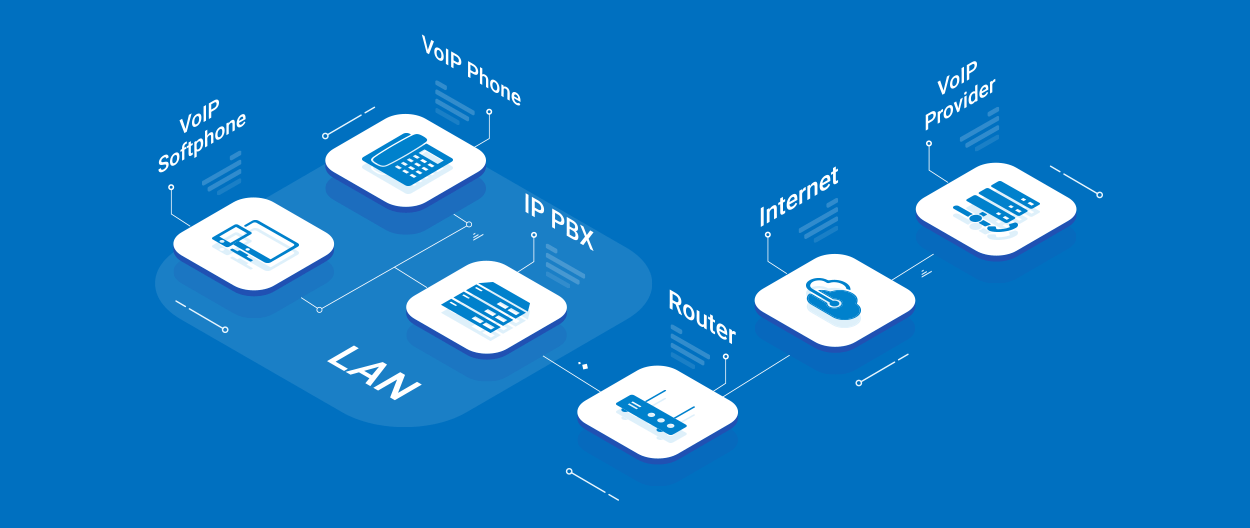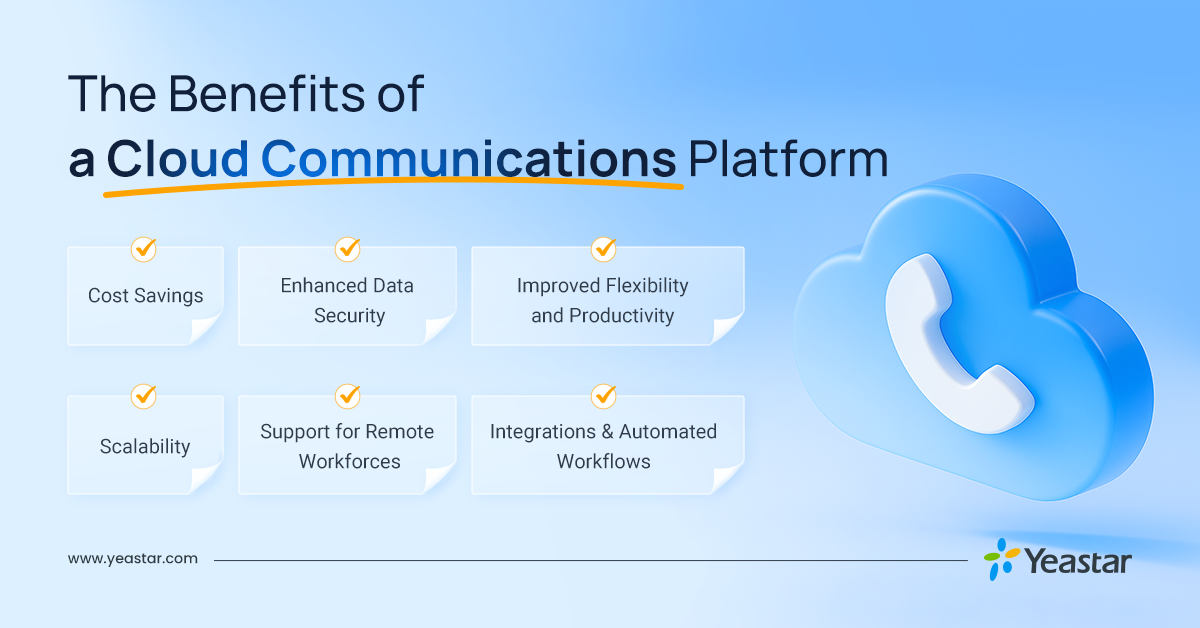
By 2025, about 94% of companies worldwide are expected to rely on some form of cloud computing. As digital transformation speeds up, businesses need communication solutions that are both efficient and flexible.
So why are so many companies ditching traditional phone systems for cloud communications? Built on cloud technology, it transforms how businesses handle calls and collaboration, offering cost-effective, scalable, and easy-to-manage solutions for remote work, customer support, and team productivity.
In this article, we’ll break down cloud communications: what it is, how it works, its benefits, and the best use cases—so you can pick the right solution for your business.
Let’s start with the basics.
Jump to ↓
- Cloud Communications Definition
- Key Components of Cloud Communications
- The Benefits of a Cloud Communications Platform
- How to Look for A Right Cloud Communications Platform?
- Grow Your Cloud Communication Business With Yeastar UCaaS Platform
- Cloud Communications FAQs
What Are Cloud Communications?
Cloud communication refers to the delivery of voice, video, messaging, and collaboration services over the internet via cloud-based platforms, rather than traditional on-premises hardware. Since everything runs over the internet and is managed by service providers, your team can communicate from anywhere, making cloud communications more scalable, flexible, and cost-effective than traditional systems.
Cloud Communications vs. Traditional Communications
| Aspects | Cloud Communications | Traditional Communications |
|---|---|---|
| Technology | Internet-based (VoIP, UCaaS, virtual PBX) | Physical phone lines (PSTN, ISDN), on-site PBX |
| Infrastructure | Hosted in the cloud by providers | On-premises hardware and wiring |
| Cost | Lower upfront costs, subscription-based | High upfront costs for hardware, ongoing maintenance |
| Features | Advanced: video, chat, integrations, analytics, automation | Basic: voice calls, limited features |
| Maintenance | Managed by provider | Managed by in-house IT or external technicians |
Key Components of Cloud Communications
Cloud communication consists of several core technologies and services that enable businesses to interact seamlessly. Below is an expanded breakdown of the key components:
Voice over Internet Protocol (VoIP)
Voice over Internet Protocol (VoIP) is one of the most common forms of cloud-based communication, it allows users to make voice and multimedia calls over the internet instead of landline services. It is essentially the technology that powers cloud-based phone systems, making modern, flexible, and scalable communication possible.

Unified Communications as a Service (UCaaS)
UCaaS takes cloud-based communication a step further by integrating voice calling, video conferencing, instant messaging, and more features into a single, unified platform. Powered by cloud infrastructure, businesses can easily scale their communication capabilities up or down based on needs. This flexibility supports growing and distributed workforces, including remote and hybrid teams.
Cloud Messaging
Cloud messaging lets businesses communicate with customers through text (SMS), pictures/videos (MMS), and live chat — all powered by internet-based platforms instead of phone carriers. This modern approach is faster, more flexible, and works across different channels.
Popular tools include:
- WhatsApp Business for customer chats
- Slack for team communication
- Telegram for fast messaging
- More

Cloud PBX Solutions
Cloud PBX (Private Branch Exchange) replaces traditional bulky phone systems with a virtual solution hosted in the cloud. It offers professional calling features such as auto attendant, voicemail-to-email, and more, all without the need for expensive hardware upkeep.
As a key part of the cloud communications ecosystem, Cloud PBX easily integrates with other tools like UCaaS and CCaaS, delivering a complete, scalable phone system that works anywhere, on any device.
The Benefits of a Cloud Communications Platform
Switching to a cloud communications platform is more than just a tech upgrade — it’s about empowering your team to work smarter, safer, and more collaboratively. Here’s how it helps businesses thrive:

Cost Savings
Cloud communications eliminate the need for expensive hardware and complex maintenance. Instead of large upfront costs, you pay based on usage, making it affordable for businesses of all sizes.
Scalability
Whether your business is growing fast or adjusting for seasonal changes, cloud communications let you easily add or remove users and features without extra hardware or delays.
Enhanced Data Security
Leading cloud providers use strong encryption, regular backups, and 24/7 monitoring to keep your communication data safe — often offering better protection than traditional on-site systems.
Improved Flexibility and Productivity
Cloud communications work seamlessly across computers, smartphones, and tablets, so you can connect and collaborate from anywhere with an internet connection. Voice, video, messaging, and file sharing come together in one platform, making teamwork faster and smoother.
Support for Remote Workforces
As remote and hybrid work become the norm, cloud communications keep your team connected no matter where they are. Employees can access all communication tools from anywhere, helping your business stay productive and adaptable.
Integrations & Automated Workflows
Cloud communications easily connect with other business tools like CRM systems. For example, when a visitor fills out a contact form on your website, their info can automatically update your CRM. This streamlines follow-ups, keeps everyone informed, and reduces errors by automating repetitive tasks — so you can focus on what really matters.
How to Look for A Right Cloud Communications Platform?
1 Define Your Business Requirements
Before choosing a cloud communications platform, clearly define your business requirements — both internally and externally. Ask yourself:
- User Scale: How many employees need access?
- Integration Needs: Which third-party tools (CRM, helpdesk, etc.) must it connect with?
- Work Model: Does your team operate hybrid/remote, or will they in the future?
Pinpoint the best cloud communications vendor by aligning their offerings with your operational requirements.
💡 For regulated industries (finance, healthcare, etc.), prioritize UCaaS platforms with enterprise-grade security, compliance certifications (HIPAA, GDPR, etc.), and auditable privacy controls.
2 Compare Customer Reviews
Once you’ve narrowed down your list of potential providers based on your business needs, the next step is to dig into customer feedback. Start by checking reputable review platforms like Gartner Peer Insights, TrustRadius, or even Google for authentic user experiences.
Remember, the most popular option isn’t always the best fit. Cloud capabilities change fast, so prioritize recent reviews that reflect current performance. Most importantly, verify the solution actually meets your specific needs and budget before committing.
💡A vendor that excels for others might not be right for you — let your business requirements guide the final decision.
3 Consider the Scalability and Future growth
When evaluating cloud communication providers, think long-term. Your business will likely grow over the next 5-10 years, so choose a platform that can scale seamlessly with your evolving team size and communication needs.
Look for a solution that continuously innovates: regular feature updates, support for emerging technologies, and a roadmap that aligns with industry trends. This ensures your communication tools won’t become outdated, keeping you competitive as market demands change.
💡The right platform should grow with your business, not hold it back.
4 Prioritize Unified Management
Ease of use and centralized control are critical, especially if you are a MSP or ITSP that manages multiple clients.
A comprehensive UCaaS solution with robust monitoring tools enables faster go-to-market execution while simplifying resource allocation. This operational efficiency translates directly into sustainable revenue streams and scalable service delivery.
💡Your management tools should reduce complexity, not create it.
Grow Your Cloud Communication Business With Yeastar UCaaS Platform Today
For service providers seeking to deliver cutting-edge cloud communications, Yeastar offers a future-ready UCaaS platform that drives growth while streamlining operations. Our solution empowers you with:
- White-label flexibility: Brand the platform as your own without infrastructure investments.
- Multi-instance efficiency: Manage multiple clients seamlessly through a single intuitive dashboard.
- Enterprise-grade capabilities: Unified communications, omnichannel contact center solutions, and seamless CRM/database integrations.
What truly sets us apart is our centralized management platform (YCM). It gives you real-time visibility, bulk automation, and remote diagnostics — slashing operational workload while boosting service performance.

To explore the full capabilities of Yeastar’s UCaaS solution and understand how it can drive your business forward, download our Solution Brochure for in-depth insights, key features, benefits, and FAQs.


